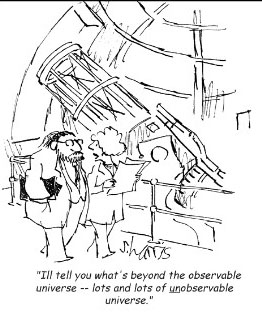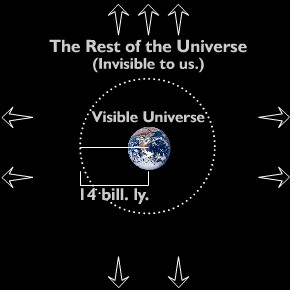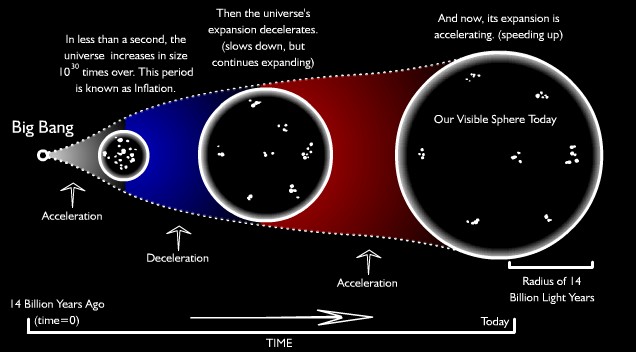The Visible Universe
The Universe is infinitely big. Even with the best imaginable telescopes, we can only see a small fraction of it. Why? Because it takes time for light to travel. So if the Universe is now 13.7 billion years old, light can only have traveled a distance of 13.7 billion light-years since the beginning of time. Thus, the part of the Universe we can observe (the Visible Universe) lies within a sphere with a radius of 13.7 billion light years centered around the Earth.

We can only observe 13.7 billion light years of the Universe.
 [2.10a] Down the Rabbit Hole: Olbers' Paradox
[2.10a] Down the Rabbit Hole: Olbers' Paradox
The Visible Universe vs. The Whole Universe
The distinction between the "Visible Universe" and the Universe in its entirety is an important one. Current models assume that the Universe is infinite and has always been so since it first came into existence. Spheres or circles labeled "Our Visible Universe" show different stages in the evolution of what we can see in the Universe today (a sphere with a radius of 13.7 billion light years across and the earth at its center).

We are only able to see the parts of the Universe whose light has had time to reach us.
The important idea is that outside any shape labeled "Our Visible Universe", the rest of the Universe exists and stretches on infinitely. Light, or any other information, cannot reach Earth from this region.
Expansion and Our Growing Visible Universe
The parameter that describes the Universe's rate of expansion is called the Hubble Constant. Far from being a constant however, the Hubble Constant has been continuously changing over the course of the Universe's 14 billion year history. We know from both observational and theoretical data that there have been at least two epochs during which the rate of expansion was accelerating or speeding up. The first and most dramatic era was inflation, which occurred briefly during the first second after the Big Bang. The second (believe it or not) is happening right now!
 [2.10b] Movie: Velocity versus Acceleration | Download
[2.10b] Movie: Velocity versus Acceleration | Download

The timeline of the Universe is not straight but curved like a bell, reflecting alternating periods of acceleration and deceleration.
As time goes on, expansion reveals more of the Universe, increasing the size of our Visible Sphere.
 [2.10c] Cosmic Conundrums: The Visible Universe
[2.10c] Cosmic Conundrums: The Visible Universe


